文艺复兴英文
- 格式:pptx
- 大小:1.23 MB
- 文档页数:11
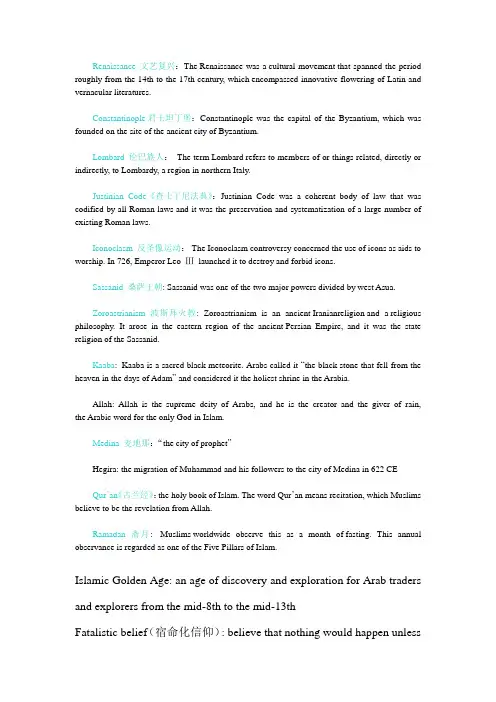
Renaissance 文艺复兴:The Renaissance was a cultural movement that spanned the period roughly from the 14th to the 17th century, which encompassed innovative flowering of Latin and vernacular literatures.Constantinople君士坦丁堡:Constantinople was the capital of the Byzantium, which was founded on the site of the ancient city of Byzantium.Lombard 伦巴族人:The term Lombard refers to members of or things related, directly or indirectly, to Lombardy, a region in northern Italy.Justinian Code《查士丁尼法典》:Justinian Code was a coherent body of law that was codified by all Roman laws and it was the preservation and systematization of a large number of existing Roman laws.Iconoclasm 反圣像运动:The Iconoclasm controversy concerned the use of icons as aids to worship. In 726, Emperor Leo Ⅲlaunched it to destroy and forbid icons.Sassanid 桑萨王朝: Sassanid was one of the two major powers divided by west Asua.Zoroastrianism 波斯拜火教: Zoroastrianism is an ancient Iranianreligion and a religious philosophy. It arose in the eastern region of the ancient Persian Empire, and it was the state religion of the Sassanid.Kaaba: K aaba is a sacred black meteorite. Arabs called it “the black stone that fell from the heaven in the days of Adam” and considered it the holiest shrine in the Arabia.Allah: Allah is the supreme deity of Arabs, and he is the creator and the giver of rain, the Arabic word for the only God in Islam.Medina 麦地那:“the city of prophet”Hegira: the migration of Muhammad and his followers to the city of Medina in 622 CEQur’an《古兰经》:the holy book of Islam. The word Qur’an means recitation, which Muslims believe to be the revelation from Allah.Ramadan 斋月: Muslims worldwide observe this as a month of fasting. This annual observance is regarded as one of the Five Pillars of Islam.Islamic Golden Age: an age of discovery and exploration for Arab traders and explorers from the mid-8th to the mid-13thFatalistic belief(宿命化信仰): believe that nothing would happen unlessthe God actively willed itKnowledge of Truth: it is not just knowledge, rather, it is "epi - gnosis"(from the Internet and can not find a exact definition)Arab numeral system(阿拉伯数字体系): a system that log with Latin numberArabian Nights(一千零一夜): also called The Book of One Thousands and One Nights, mostly a compilation of earlier folk tales.Feudalism(封建制度): the social system that developed in Europe in the 8th century; vassals were protected by lords who they had to serve in war Charlemagne(查理曼大帝): (also called Charles the Great) the greatest Frankish king who established the vast Carolingian EmpireCarolus Magnus: the Latin version of Charlemagne’s nameVassal(封臣): a person holding a fief; a person who owes allegiance and service to a feudal lordCounty(郡): distinct similar to the Roman ProvinceCount(伯爵): the administrator, judge and military leader of the county Clergy(什一税): 10% income taxDark Ages: the two centuries after Carolingian Empire collapsed which Western Europe being attached by non-Christian invadersTribute(贡金):money that forced to pay to the invaders after being occupiedNormandy(诺曼底): (also called “land of Norse”) the part of the northern Frankish coastal region which under Norseman’s control in 911 Vassalage(采邑制,封臣制): the relationship between a vassal and his lordCrusader(十字军):a warrior who engages in a holy warTreaty of Verdun(凡尔登条约): a treaty that divided the Carolingian Empire into three parts in 843, signed by Louis the PiousTreaty of Meerssen(莫尔森条约): a treaty signed in 870 that ended the civil war between the East Franks and the West Franks。
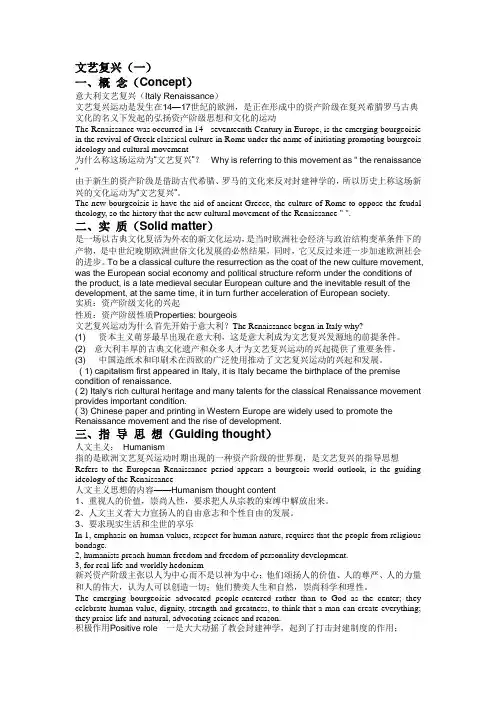
文艺复兴(一)一、概念(Concept)意大利文艺复兴(Italy Renaissance)文艺复兴运动是发生在14—17世纪的欧洲,是正在形成中的资产阶级在复兴希腊罗马古典文化的名义下发起的弘扬资产阶级思想和文化的运动The Renaissance was occurred in 14 - seventeenth Century in Europe, is the emerging bourgeoisie in the revival of Greek classical culture in Rome under the name of initiating promoting bourgeois ideology and cultural movement为什么称这场运动为“文艺复兴”?Why is referring to this movement as " the renaissance "由于新生的资产阶级是借助古代希腊、罗马的文化来反对封建神学的,所以历史上称这场新兴的文化运动为“文艺复兴”。
The new bourgeoisie is have the aid of ancient Greece, the culture of Rome to oppose the feudal theology, so the history that the new cultural movement of the Renaissance " ".二、实质(Solid matter)是一场以古典文化复活为外衣的新文化运动,是当时欧洲社会经济与政治结构变革条件下的产物,是中世纪晚期欧洲世俗文化发展的必然结果,同时,它又反过来进一步加速欧洲社会的进步。
To be a classical culture the resurrection as the coat of the new culture movement, was the European social economy and political structure reform under the conditions of the product, is a late medieval secular European culture and the inevitable result of the development, at the same time, it in turn further acceleration of European society.实质:资产阶级文化的兴起性质:资产阶级性质Properties: bourgeois文艺复兴运动为什么首先开始于意大利?The Renaissance began in Italy why?(1) 资本主义萌芽最早出现在意大利,这是意大利成为文艺复兴发源地的前提条件。
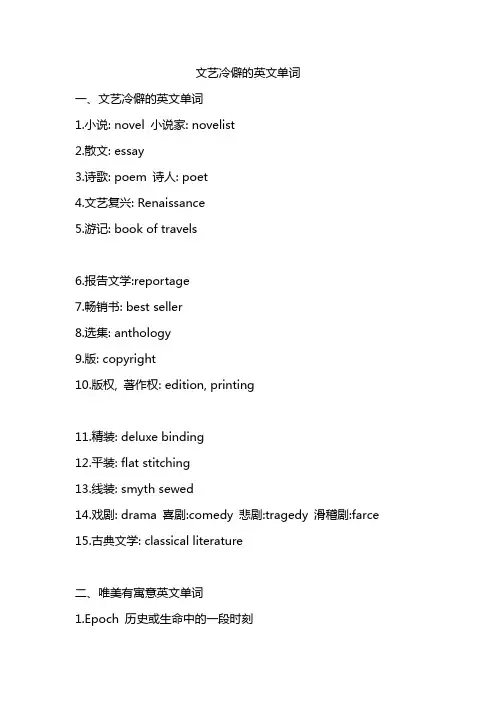
文艺冷僻的英文单词一、文艺冷僻的英文单词1.小说: novel 小说家: novelist2.散文: essay3.诗歌: poem 诗人: poet4.文艺复兴: Renaissance5.游记: book of travels6.报告文学:reportage7.畅销书: best seller8.选集: anthology9.版: copyright10.版权, 著作权: edition, printing11.精装: deluxe binding12.平装: flat stitching13.线装: smyth sewed14.戏剧: drama 喜剧:comedy 悲剧:tragedy 滑稽剧:farce15.古典文学: classical literature二、唯美有寓意英文单词1.Epoch 历史或生命中的一段时刻2.Somnambulist 梦游症患者3.Ineffable 形容美到难以言喻4.Petrichor 雨下过以后,泥土的香味5.Mellifluous 形容声音甜美6.Serendipity 意外发现有趣、新奇事物的天赋7.Sonorous 形容低沉、浑厚的声音8.Aquiver 形容兴奋到发抖的感受9.Limerence 因为一个人而神魂颠倒的状态10.Hiraeth 对于无法回去或不曾存在的家所产生的乡愁11.Bombinate 发出嗡嗡声响12.Ethereal 形容脱俗的高雅13.Illicit 形容非法、不当14.Nefarious 形容极其凶恶15.Iridescent 形容彩虹般的五颜六色。
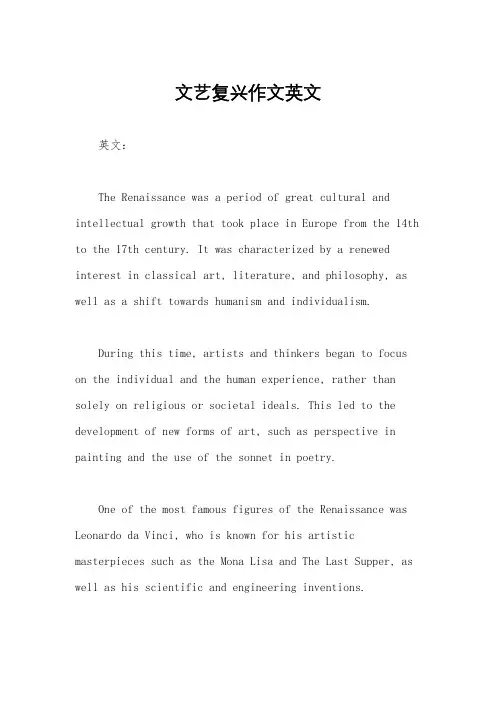
文艺复兴作文英文英文:The Renaissance was a period of great cultural and intellectual growth that took place in Europe from the 14th to the 17th century. It was characterized by a renewed interest in classical art, literature, and philosophy, as well as a shift towards humanism and individualism.During this time, artists and thinkers began to focus on the individual and the human experience, rather than solely on religious or societal ideals. This led to the development of new forms of art, such as perspective in painting and the use of the sonnet in poetry.One of the most famous figures of the Renaissance was Leonardo da Vinci, who is known for his artistic masterpieces such as the Mona Lisa and The Last Supper, as well as his scientific and engineering inventions.The Renaissance had a profound impact on Western civilization, shaping the way we think about art, science, and the individual. It paved the way for the Enlightenment and the Scientific Revolution, which built upon the humanistic ideals of the Renaissance.中文:文艺复兴是欧洲14世纪到17世纪的一段文化和知识增长的时期。
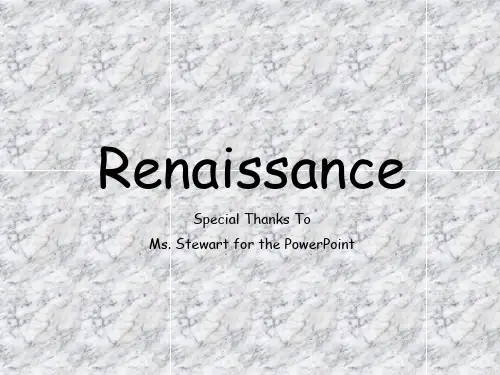
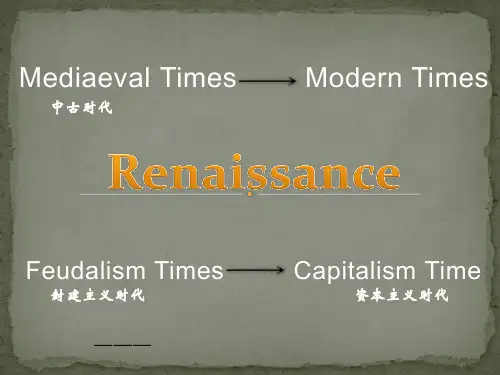
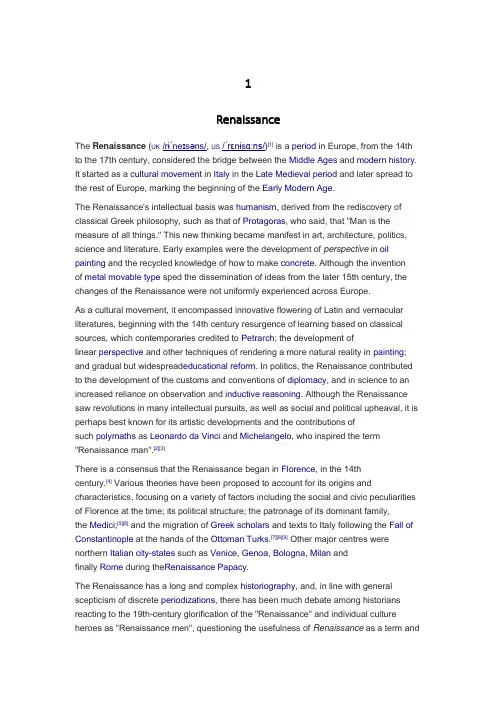
1RenaissanceThe Renaissance (UK/rɨˈneɪsəns/, US/ˈrɛnɨsɑːns/)[1] is a period in Europe, from the 14th to the 17th century, considered the bridge between the Middle Ages and modern history. It started as a cultural movement in Italy in the Late Medieval period and later spread to the rest of Europe, marking the beginning of the Early Modern Age.The Renaissance's intellectual basis was humanism, derived from the rediscovery of classical Greek philosophy, such as that of Protagoras, who said, that "Man is the measure of all things." This new thinking became manifest in art, architecture, politics, science and literature. Early examples were the development of perspective in oil painting and the recycled knowledge of how to make concrete. Although the inventionof metal movable type sped the dissemination of ideas from the later 15th century, the changes of the Renaissance were not uniformly experienced across Europe.As a cultural movement, it encompassed innovative flowering of Latin and vernacular literatures, beginning with the 14th century resurgence of learning based on classical sources, which contemporaries credited to Petrarch; the development oflinear perspective and other techniques of rendering a more natural reality in painting; and gradual but widespread educational reform. In politics, the Renaissance contributed to the development of the customs and conventions of diplomacy, and in science to an increased reliance on observation and inductive reasoning. Although the Renaissance saw revolutions in many intellectual pursuits, as well as social and political upheaval, it is perhaps best known for its artistic developments and the contributions ofsuch polymaths as Leonardo da Vinci and Michelangelo, who inspired the term "Renaissance man".[2][3]There is a consensus that the Renaissance began in Florence, in the 14thcentury.[4] Various theories have been proposed to account for its origins and characteristics, focusing on a variety of factors including the social and civic peculiarities of Florence at the time; its political structure; the patronage of its dominant family,the Medici;[5][6] and the migration of Greek scholars and texts to Italy following the Fall of Constantinople at the hands of the Ottoman Turks.[7][8][9] Other major centres were northern Italian city-states such as Venice, Genoa, Bologna, Milan andfinally Rome during the Renaissance Papacy.The Renaissance has a long and complex historiography, and, in line with general scepticism of discrete periodizations, there has been much debate among historians reacting to the 19th-century glorification of the "Renaissance" and individual culture heroes as "Renaissance men", questioning the usefulness of Renaissance as a term andas a historical delineation.[10] The art historian Erwin Panofsky observed of this resistance to the concept of "Renaissance":It is perhaps no accident that the factuality of the Italian Renaissance has been most vigorously questioned by those who are not obliged to take a professional interest in the aesthetic aspects of civilization—historians of economic and social developments, political and religious situations, and, most particularly, natural science—but only exceptionally by students of literature and hardly ever by historians of Art.[11]Some observers have called into question whether the Renaissance was a cultural "advance" from the Middle Ages, instead seeing it as a period of pessimismand nostalgia for classical antiquity,[12] while social and economic historians, especially of the longue durée, have instead focused on the continuity between the two eras[13] which are linked, as Panofsky himself observed, "by a thousand ties".[14]The word Renaissance, literally meaning "Rebirth" in French, first appears in English in the 1830s.[15] The word occurs in Jules Michelet's 1855 work, Histoire de France. The word Renaissance has also been extended to other historical and cultural movements, such as the Carolingian Renaissance and the Renaissance of the 12th century.[16]2RepresentativesAlfred Tennyson, among many others. In addition, the first use of the interlockingthree-line rhyme scheme, or the terza rima, is attributed to him.Dante has been called "the Father of the Italian language".[2] In Italy, Dante is often referred to as il Sommo Poeta("the Supreme Poet") and il Poeta; he, Petrarch, and Boccaccio are also called "the three fountains" or "the three crowns".The Divine Comedy describes Dante's journeythrough Hell (Inferno), Purgatory (Purgatorio), and Paradise (Paradiso)Dante, like most Florentines of his day, was embroiled in the Guelph–Ghibelline conflict. He fought in the Battle of Campaldino (June 11, 1289), with the Florentine Guelphs against Arezzo Ghibellines; then in 1294 he was among the escorts of Charles Martel of Anjou (grandson of Charles I of Naples, more commonly called Charles of Anjou) while he was in Florence. To further his political career, he became a pharmacist. He did not intend to practice as one, but a law issued in 1295 required nobles aspiring to public office to be enrolled in one of the CorporazionidelleArti e deiMestieri, so Dante obtained admission to the Apothecaries' Guild. This profession was not inappropriate, since at that time books were sold from apothecaries' shops. As a politician he accomplished little, but held various offices over some years in a city rife with political unrest.After defeating the Ghibellines, the Guelphs divided into two factions: the White Guelphs (Guelfi Bianchi)—Dante's party, led by VierideiCerchi—and the Black Guelphs (GuelfiNeri), led by Corso Donati. Although the split was along family lines at first, ideological differences arose based on opposing views of the papal role in Florentine affairs, with the Blacks supporting the Pope and the Whites wanting more freedom from Rome. The Whites took power first and expelled the Blacks. In response, Pope Boniface VIII planned a military occupation of Florence. In 1301, Charles of Valois, brother ofKing Philip IV of France, was expected to visit Florence because the Pope had appointed him peacemaker for Tuscany. But the city's government had treated the Pope's ambassadors badly a few weeks before, seeking independence from papal influence. It was believed that Charles had received other unofficial instructions, so the council sent a delegation to Rome to ascertain the Pope's intentions. Dante was one of the delegates.2. Leonardo da Vinci。
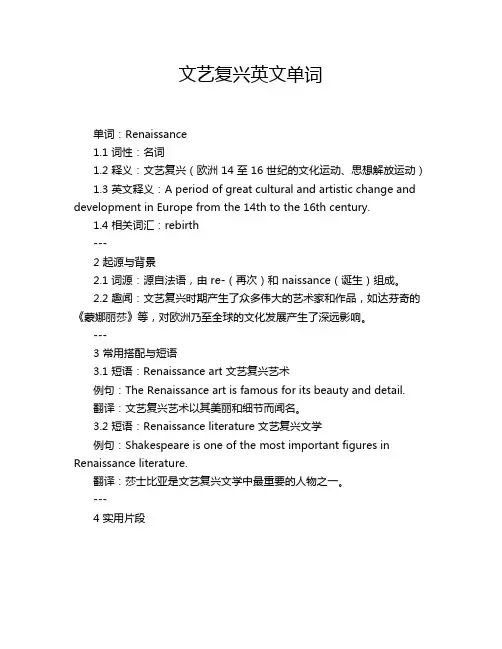
文艺复兴英文单词单词:Renaissance1.1 词性:名词1.2 释义:文艺复兴(欧洲 14 至 16 世纪的文化运动、思想解放运动)1.3 英文释义:A period of great cultural and artistic change and development in Europe from the 14th to the 16th century.1.4 相关词汇:rebirth---2 起源与背景2.1 词源:源自法语,由 re-(再次)和 naissance(诞生)组成。
2.2 趣闻:文艺复兴时期产生了众多伟大的艺术家和作品,如达芬奇的《蒙娜丽莎》等,对欧洲乃至全球的文化发展产生了深远影响。
---3 常用搭配与短语3.1 短语:Renaissance art 文艺复兴艺术例句:The Renaissance art is famous for its beauty and detail.翻译:文艺复兴艺术以其美丽和细节而闻名。
3.2 短语:Renaissance literature 文艺复兴文学例句:Shakespeare is one of the most important figures in Renaissance literature.翻译:莎士比亚是文艺复兴文学中最重要的人物之一。
---4 实用片段(1) "I'm studying the Renaissance period in history class. It's so fascinating to learn about the great thinkers and artists of that time." said Tom. "Yes, the Renaissance was a time of great innovation and creativity." replied the teacher.翻译:“我在历史课上学习文艺复兴时期。
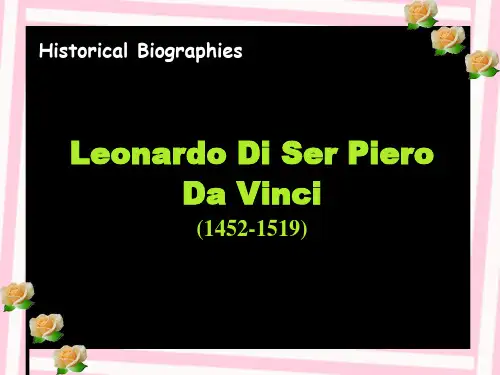
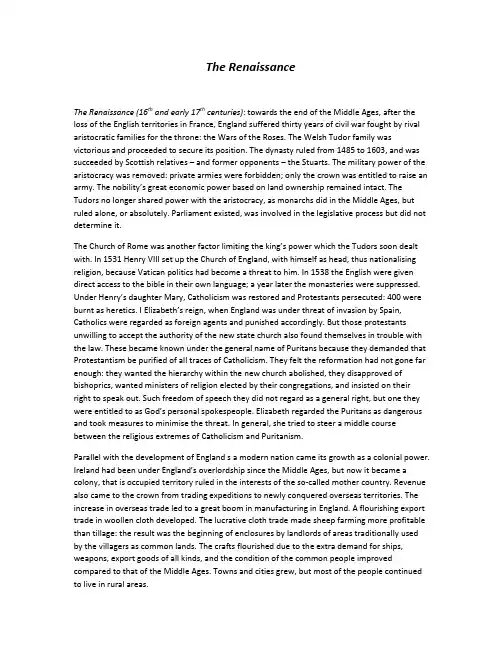
The RenaissanceThe Renaissance (16th and early 17th centuries): towards the end of the Middle Ages, after the loss of the English territories in France, England suffered thirty years of civil war fought by rival aristocratic families for the throne: the Wars of the Roses. The Welsh Tudor family was victorious and proceeded to secure its position. The dynasty ruled from 1485 to 1603, and was succeeded by Scottish relatives – and former opponents – the Stuarts. The military power of the aristocracy was removed: private armies were forbidden; only the crown was entitled to raise an army. The nobility’s great economic power based on land ownership remained intact. The Tudors no longer shared power with the aristocracy, as monarchs did in the Middle Ages, but ruled alone, or absolutely. Parliament existed, was involved in the legislative process but did not determine it.The Church of Rome was another factor limiting the king’s power which the Tudors soon dealt with. In 1531 Henry VIII set up the Church of England, with himself as head, thus nationalising religion, because Vatican politics had become a threat to him. In 1538 the English were given direct access to the bible in their own language; a year later the monasteries were suppressed. Under Henry’s daughte r Mary, Catholicism was restored and Protestants persecuted: 400 were burnt as heretics. I Elizabeth’s reign, when England was under threat of invasion by Spain, Catholics were regarded as foreign agents and punished accordingly. But those protestants unwilling to accept the authority of the new state church also found themselves in trouble with the law. These became known under the general name of Puritans because they demanded that Protestantism be purified of all traces of Catholicism. They felt the reformation had not gone far enough: they wanted the hierarchy within the new church abolished, they disapproved of bishoprics, wanted ministers of religion elected by their congregations, and insisted on their right to speak out. Such freedom of speech they did not regard as a general right, but one they were entitled to as God’s personal spokespeople. Elizabeth regarded the Puritans as dangerous and took measures to minimise the threat. In general, she tried to steer a middle course between the religious extremes of Catholicism and Puritanism.Parallel with the development of England s a modern nation came its growth as a colonial power. Ireland had been under England’s overlordship since the Middle Ages, but now it became a colony, that is occupied territory ruled in the interests of the so-called mother country. Revenue also came to the crown from trading expeditions to newly conquered overseas territories. The increase in overseas trade led to a great boom in manufacturing in England. A flourishing export trade in woollen cloth developed. The lucrative cloth trade made sheep farming more profitable than tillage: the result was the beginning of enclosures by landlords of areas traditionally used by the villagers as common lands. The crafts flourished due to the extra demand for ships, weapons, export goods of all kinds, and the condition of the common people improved compared to that of the Middle Ages. Towns and cities grew, but most of the people continued to live in rural areas.During the 16th and early 17th centuries, therefore, the people of England transformed the basis of their national and spiritual life. They also broadened their intellectual horizons and fashioned from a newly augmented language one of the great literatures of the western world. The period is known as the Renaissance; the term Renaissance (‘rebirth’) originally indicated a revival of classical (Greek and Roman) arts and sciences after the dark ages of medieval obscurantism. Renaissance writers returned to the classical sources of ‘humane letter’ in an attempt to find new ways of generating ideas and promoting a written and spoken eloquence greater in purity than the crabbed Latin of Medieval schoolmen.In line with the period’s enthusiasm for classical literature and art is a renewed b elief in humanism (a belief in human-based morality rather than in any supernatural authority). They believed, as Alexander Pope was to phrase it much later, that ‘the proper study of mankind is man’, rather than scholastic theology. For humanists the divi ne principle of reason was the guideline and that they found better realised in the classical world of antiquity than in the Middle Ages. They hoped to create a new civilisation in Europe at least equalling that of the old world. Thomas More wrote Utopia (1516) in which he puts forward his ideal of a future happy society. More’s book owes a considerable debt to Plato’s Republic and the Greek satirist Lucian. More’s topics include the corruption of the rich, the sufferings of the poor and the injustice of the death penalty for starving thieves. For More, only Utopia, where private property has been abolished, offers hope of an ideal state. The irony lies in the fact that utopia means ‘nowhere’. Utopia, however, provided a blueprint for a high-minded, money-free collective where a rational code is valued.Humanist ideals led to a widespread concern with education and many schools were formed, especially for boys who were educated in the faith of Christ and in classical literature (girls were for centuries deprived of a formal education). The study of Christian and pagan authors was seen as the best way to prepare men for the vicissitudes of life. Thus classical authors were studied as guides to life. An important aspect of the rhetorical training of the humanist schools in the Renaissance was the absorption of large numbers of received conventions or commonplaces of description (such as traditional similes) called topoi. All Renaissance students were taught, as part of their basic training, to amplify, vary, and enrich these topoi or received ideas in novel or copious ways. Shakespeare’s Sonnet 73 (1609) can be seen as a virtuoso example of this Renaissance rhetorical training in which the poem’s speaker attempts to persuade the addressee to regard him in a certain way. Each of the quatrains contains a different, extended metaphor for the speaker’s age or condition: (i) as late autumn, (ii) as twilight, (iii) as a dying fire. All three metaphors are commonplace ways, or received topoi, of representing old age, yet the interesting thing about the poem is that it revitalises these ‘old’ or ‘tired’ metaphors by extending them, and making them precise and specific rather than vaguely general.A further shaping influence on the literature of the period were the religious movements of the Reformation. The authority of the Catholic Church was no longer seen as infallible; indeed, ordinary individuals believed that they did not need the help of a priest to interpret scripture.Luther did not believe that the Catholic Church could save souls but that a man’s salvation depended on God’s grace and justification by faith alone. Private experience became the means of the deepest spiritual discovery. Reading scripture became more important than listening to a priest. There was a move here towards individualism.Both Protestantism and humanism had a formative influence on the genius of William Shakespeare. In common with other Elizabethan dramatists, his dramas broke away from the religious domination evident in the crypto-Catholic mystery and morality plays of the medieval era, and show an interest in the classics that is matched by a vivid social realism. Of all his dramas, the tragedies are generally regarded as Shakespeare’s supreme achievement. As in Greek tragedy, many of the main figures are kings and queens (e. g. Claudius and Gertrude in Hamlet); ordinary individuals are not yet considered appropriate vehicles for edification. However, we do not remember Hamlet because he is the king’s son but, rather, because of his personality. During the Tudor age the fate of a nation depended to a greater extent than in medieval times on the character of the rulers; it is therefore not surprising that drama produced the greatest literary individuals the stage had ever seen. The tragic fate of these individuals is not caused by external forces outside their control but is of their own making: their downfall is caused by specific features of character or weaknesses exposed under exceptional circumstances. Consider Hamlet’s inability to make up his mind, for example; a tragic flaw that led to his own death and the death of many innocent people. The tumultuous nature of his time had made Shakespeare acutely aware of the precariousness of fortune and character, and how quickly the veneer of civilisation could disintegrate under adverse conditions.Sonnet no. 73 (William Shakespeare)That time of year thou mayest in me beholdWhen yellow leaves, or none, or few, do hangUpon those boughs which shake against the cold,bare ruin'd choirs, where late the sweet birds sang.In me thou see'st the twilight of such dayAs after sunset fadeth in the west,Which by and by black night doth take away,Death's second self, that seals up all in rest.In me thou see'st the glowing of such fire,That on the ashes of his youth doth lie,As the death-bed whereon it must expireConsum'd with that which it was nourish'd by. This thou perceiv'st, which makes thy love more strong, To love that well which thou must leave ere long.(i)Identify the conceit and ‘Volta’ in Sonnet 73.。
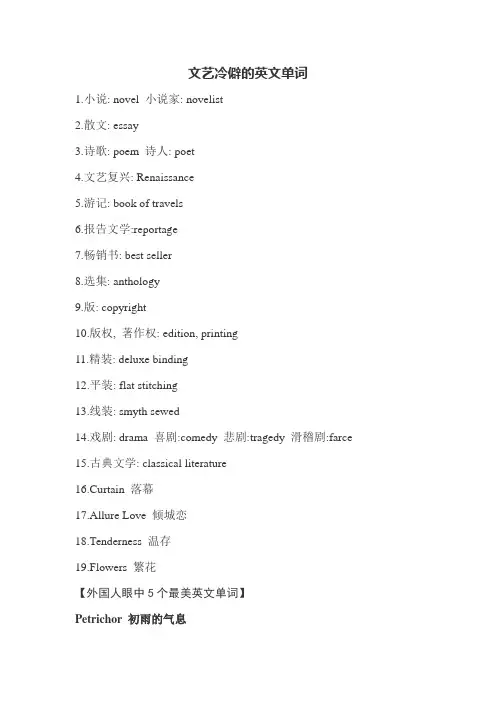
文艺冷僻的英文单词1.小说: novel 小说家: novelist2.散文: essay3.诗歌: poem 诗人: poet4.文艺复兴: Renaissance5.游记: book of travels6.报告文学:reportage7.畅销书: best seller8.选集: anthology9.版: copyright10.版权, 著作权: edition, printing11.精装: deluxe binding12.平装: flat stitching13.线装: smyth sewed14.戏剧: drama 喜剧:comedy 悲剧:tragedy 滑稽剧:farce15.古典文学: classical literature16.Curtain 落幕17.Allure Love 倾城恋18.Tenderness 温存19.Flowers 繁花【外国人眼中5个最美英文单词】Petrichor 初雨的气息A pleasant smell that frequently accompanies the first rain after a long period of warm, dry weather。
很长一段温暖、干燥的天气后,第一场雨带来的清香。
petrichor,这个单词的英文释义那么美,可是如果查有道词典的话会显示是“潮土油”这么low又费解的词义。
为什么?词根petr-表石头,太多西方人的教名Peter其实就是“磐石”之意,再如petroleum石油。
而-ichor则是希腊神话中神仙体内流淌的“神液”,即神的血液。
希腊神话中青铜巨人[微博]Talos塔罗斯全身青铜铸就,所向无敌。
只有一根血管,从颈部通下,其内流淌着ichor直到膝盖处以铜钮遮掩。
阿尔戈号船员取得金羊毛后要在Talos所在的岛屿登陆,Talos阻止时被Medea拔掉了铜纽,金黄色的ichor流淌了满地而死。
The RenaissanceT he Renaissance refers to the period in European civilization towards the end of the Middle Ages, which was characterized by a surge of interest in classical learning and values.1.The origin of the RenaissanceThe Renaissance emerged when social instability, economic sluggishness and intellectual depression became so intolerable that most of the people, especially the intellectuals could no longer accept the worsening situation. The Renaissance as a movement first started in Florence and then expanded to Venice, Rome and other Italian cities before it swept the rest parts of Europe. Painting and sculpture were the most sensitive fields to the change with their subjects and tastes, shifting from dullness, stagnation, lack of emotion and divinity to dynamics, enthusiasm and humanitarianism. Literature and ideology soon followed as other important areas proceeded and the movement further separated itself from feudalistic tyranny, ecclesiastic bondage and sought intellectual freedom and ideological emancipation.2.The characteristics of the RenaissanceThe Renaissance is characterized by seeking ideological emancipation, intellectual freedom and political awareness, based on cultural production and religious reformation. All these were undertaken or unfolded gradually but widely, extending its influences to every corner of Europe, with more and more people getting involved. The achievements were seen principally in six areas, namely, painting, sculpture, poetry, fiction, drama and religious reformation as well as the change in the cultural and intellectual climate.3.The influence of the RenaissanceThe Renaissance was an important stage in the historical process of the Western civilization and indicated a transitional period from the Middle Ages to the modern era in the development of Western culture. Economic and intellectual changes during the Renaissance both helped to speed up Western social and cultural development and prepared the necessary conditions for the rapid progress in political, social and ideological areas of the Modern Age.文艺复兴是指由于意大利最早产生了资本主义萌芽,13世纪末在意大利兴起,以后扩散到西欧各国,16世纪盛行的一场思想文化运动。
Following the explosion of creativity in Florence during the 14th century known as the Renaissance, the modern world saw a departure from what it had once known. It turned from God and the authority of the Roman Catholic Church and instead favoured a more humanistic approach to being. Renaissance ideas had spread throughout Europe well into the 17th century, with the arts and sciences flourishing extraordinarily among those with a more logical disposition. 1.With (the gap between) the church's teachings and ways of thinking being eclipsed by the Renaissance, the gap between the medieval and modern periods had been bridged, leading to new and unexplored intellectual territories.During the Renaissance, the great minds of Nicolaus Copernicus, Johannes Kepler and Galileo Galilei demonstrated the power of scientific study and discovery. 2. Before each of their revelations, many thinkers at the time had sustained more ancient ways of thinking, including the geocentric view that the Earth was at the centre of our universe. Copernicus theorized in 1543 that in actual fact, all of the planets that we knew of revolved not around the Earth, but the Sun, a system that was later upheld by Galileo at his own expense. Offering up such a theory during a time of high tension between scientific and religious minds was branded as heresy,and any such heretics that continued to spread these lies were to be punished by imprisonment or even death. Galileo was excommunicated by the Church and imprisoned for life for his astronomical observations and his support of the heliocentric principle.3.Despite attempts by the Church to strong-arm this new generation oflogicians and rationalists, more explanations for how the universe functioned were being made,and at a rate that the people-including the Church -could no longer ignore. It was with these great revelations that a new kind ofphilosophy founded in reason was born.The Church's long-standing dogma was losing the great battle for truth to rationalists and scientists. This very fact embodied the new ways of thinking that swept through Europe during most of the 17th century. 4. As many took on the duty of trying to integrate reasoning and scientific philosophies into the world. The Renaissance was over and it was time for a new era-the Age of Reason.The 17th and 18th centuries were times of radical change and curiosity. Scientific method,reductionism and the questioning of Church ideals was to be encouraged, as were ideas of liberty, tolerance and progress. 5. Such actions to seek knowledge and to understand what information we already knew were captured by the Latin phrase'sapere aude'or 'dare to know', after Immanuel Kant used it in his essay An Answer to the Question: What is Enlightenment? It was the purpose and responsibility of great minds to go forth and seek out the truth, which they believed to be founded in knowledge.。
文艺复兴(一)一、概念(Concept)意大利文艺复兴(Italy Renaissance)文艺复兴运动是发生在14—17世纪的欧洲,是正在形成中的资产阶级在复兴希腊罗马古典文化的名义下发起的弘扬资产阶级思想和文化的运动The Renaissance was occurred in 14 - seventeenth Century in Europe, is the emerging bourgeoisie in the revival of Greek classical culture in Rome under the name of initiating promoting bourgeois ideology and cultural movement为什么称这场运动为“文艺复兴”?Why is referring to this movement as " the renaissance "由于新生的资产阶级是借助古代希腊、罗马的文化来反对封建神学的,所以历史上称这场新兴的文化运动为“文艺复兴”。
The new bourgeoisie is have the aid of ancient Greece, the culture of Rome to oppose the feudal theology, so the history that the new cultural movement of the Renaissance " ".二、实质(Solid matter)是一场以古典文化复活为外衣的新文化运动,是当时欧洲社会经济与政治结构变革条件下的产物,是中世纪晚期欧洲世俗文化发展的必然结果,同时,它又反过来进一步加速欧洲社会的进步。
To be a classical culture the resurrection as the coat of the new culture movement, was the European social economy and political structure reform under the conditions of the product, is a late medieval secular European culture and the inevitable result of the development, at the same time, it in turn further acceleration of European society.实质:资产阶级文化的兴起性质:资产阶级性质Properties: bourgeois文艺复兴运动为什么首先开始于意大利?The Renaissance began in Italy why?(1) 资本主义萌芽最早出现在意大利,这是意大利成为文艺复兴发源地的前提条件。
复兴的英语单词单词:renaissance1. 定义与释义1.1词性:名词1.2释义:复兴;复活;新生;文艺复兴(欧洲14 - 16世纪的思想与艺术运动)1.3英文解释:A revival or renewal, especially in art, literature, etc.; the period of European history between the 14th and 16th centuries when there was a new interest in ancient art, literature, and learning.1.4相关词汇:revival(复兴,复活),renewal(更新,复兴),rejuvenation(复原,恢复活力),resurgence(复活,再现)2. 起源与背景2.1词源:“renaissance”一词源于法语,法语又源于拉丁语“renascī”,意思是“重生,再生”。
2.2趣闻:文艺复兴时期涌现出了许多伟大的艺术家、文学家和科学家。
例如达·芬奇,他不仅是画家,还是发明家、科学家等多领域的天才人物。
他的画作《蒙娜丽莎》和《最后的晚餐》至今都是举世闻名的艺术瑰宝。
这个时期是人类思想和文化的一次巨大飞跃,就像“renaissance”这个词表达的一样,是一种在文化艺术等多方面的重生。
3. 常用搭配与短语3.1短语:(1) Renaissance art:文艺复兴时期的艺术例句:Renaissance art has had a profound influence on Western art history.翻译:文艺复兴时期的艺术对西方艺术史有着深远的影响。
(2) economic renaissance:经济复兴例句:The government is working hard to bring about an economic renaissance in this region.翻译:政府正在努力使这个地区实现经济复兴。
初中历史文艺复兴知识点整理文艺复兴(Renaissance)是指发生在14世纪到16世纪的一场反映新兴资产阶级要求的欧洲思想文化运动。
下面给大家带来一些关于初中历史文艺复兴知识点整理,希望对大家有所帮助。
一.基本内容“文艺复兴”的概念在14-16世纪时已被意大利的人文主义作家和学者所使用。
当时的人们认为,文艺在希腊、罗马古典时代曾高度繁荣,但在中世纪“黑暗时代”却衰败湮没,直到14世纪后才获得“再生”与“复兴”,因此称为“文艺复兴”。
文艺复兴最先在意大利各城邦兴起,以后扩展到西欧各国,于16世纪达到顶峰,带来一段科学与艺术革命时期,揭开了近代欧洲历史的序幕,被认为是中古时代和近代的分界。
文艺复兴是西欧近代三大思想解放运动(文艺复兴、宗教改革与启蒙运动)之一。
11世纪后,随着经济的复苏与发展、城市的兴起与生活水平的提高,人们逐渐改变了以往对现实生活的悲观绝望态度,开始追求世俗人生的乐趣,而这些倾向是与天主教的主张相违背的。
在14世纪城市经济繁荣的意大利,最先出现了对天主教文化的反抗。
当时意大利的市民和世俗知识分子,一方面极度厌恶天主教的神权地位极其虚伪的禁欲主义,另一方面由于没有成熟的文化体系取代天主教文化,于是他们借助复兴古代希腊、罗马文化的形式来表达自己的文化主张。
因此,文艺复兴着重表明了新文化以古典为师的一面,而并非单纯的古典复兴,实际上是资产阶级反封建的新文化运动。
二.内涵文艺复兴(英文:Renaissance 意大利文:Rinascimento,由ri-“重新”和nascere“出生”构成,法文:La Renaissance)是14世纪中叶至16世纪在欧洲发生的思想文化运动,它在近代早期深刻地影响了欧洲的知识生活。
一般认为在中世纪晚期发源于佛罗伦萨,但存在异议。
意大利其他重要的中心有威尼斯、热那亚、米兰、那不勒斯、博洛尼亚、最后是教宗的罗马。
从意大利开始,到16世纪一直传播到欧洲其他地区,其影响力在艺术,建筑,哲学,文学,音乐,科学技术,政治,宗教以及智力探究的其他方面都得到了体现。